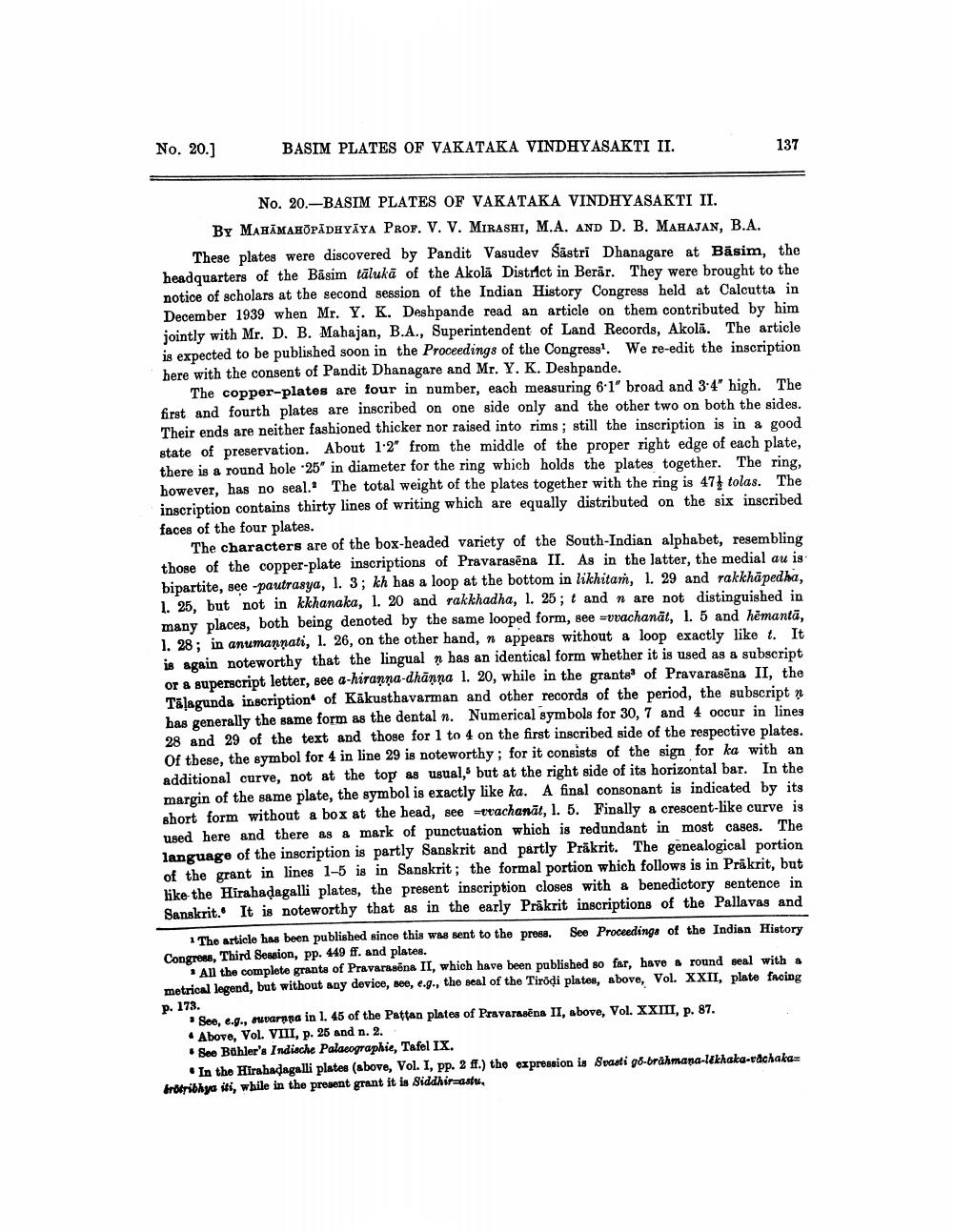________________
No. 20.]
BASIM PLATES OF VAKATAKA VINDHYASAKTI II.
137
No. 20.-BASIM PLATES OF VAKATAKA VINDHYASAKTI II. BY MAHĀMAHÕPĪDHYĀYA PROF. V. V. MIRASHI, M.A. AND D. B. MAHAJAN, B.A.
These plates were discovered by Pandit Vasudev Sastri Dhanagare at Bāsim. the headquarters of the Bāsim tālukā of the Akola District in Berār. They were brought to the notice of scholars at the second session of the Indian History Congress held at Calcutta in December 1939 when Mr. Y. K. Deshpande read an article on them contributed by him jointly with Mr. D. B. Mahajan, B.A., Superintendent of Land Records, Akola. The article is expected to be published soon in the Proceedings of the Congress. We re-edit the inscription here with the consent of Pandit Dhanagare and Mr. Y. K. Deshpande.
The copper-plates are four in number, each measuring 6·1' broad and 3:4" high. The first and fourth plates are inscribed on one side only and the other two on both the sides. Their ends are neither fashioned thicker nor raised into rims; still the inscription is in a good state of preservation. About 1.2" from the middle of the proper right edge of each plate, there is a round hole .25" in diameter for the ring which holds the plates together. The ring, however, has no seal. The total weight of the plates together with the ring is 47 tolas. The inscription contains thirty lines of writing which are equally distributed on the six inscribed faces of the four plates.
The characters are of the box-headed variety of the South Indian alphabet, resembling those of the copper-plate inscriptions of Pravarasēna II. As in the latter, the medial au is bipartite, see pautrasya, 1. 3; kh has a loop at the bottom in likhitam, l. 29 and rakkhāpedha, 1. 25, but not in kkhanaka, I. 20 and rakkhadha, 1. 25; t and n are not distinguished in many places, both being denoted by the same looped form, see =vvachanat, 1. 5 and hēmantā, 1. 28; in anumannati, 1. 26, on the other hand, n appears without a loop exactly like t. It is again noteworthy that the lingual n has an identical form whether it is used as a subscript or a superscript letter, see a-hiranna-dhānna l. 20, while in the grante' of Pravarasēna II, the Talagunda inscription of Käkusthavarman and other records of the period, the subscript n has generally the same form as the dental n. Numerical symbols for 30, 7 and 4 occur in lines 28 and 29 of the text and those for 1 to 4 on the first inscribed side of the respective plates. Of these, the symbol for 4 in line 29 is noteworthy; for it consists of the sign for ka with an additional curve, not at the top as usual, but at the right side of its horizontal bar. In the margin of the same plate, the symbol is exactly like ka. A final consonant is indicated by its short form without a box at the head, see =trachanāt, 1. 5. Finally a crescent-like curve ig used here and there as a mark of punctuation which is redundant in most cases. The language of the inscription is partly Sanskrit and partly Prākrit. The genealogical portion of the grant in lines 1-5 is in Sanskrit; the formal portion which follows is in Prakrit, but like the Hirahadagalli plates, the present inscription closes with a benedictory sentence in Sanskrit. It is noteworthy that as in the early Prākrit inscriptions of the Pallavas and
1 The article has been published since this was sent to the presa. See Proceedings of the Indian History Congress, Third Session, pp. 449 ff. and plates.
* All the complete grants of Pravarssons II, which have been published so far, have a round seal with a metrical legend, but without any device, nee, e.g., the seal of the Tirodi plates, above, Vol. XXII, plate freing p. 173.
See, e.g., muarona in l. 45 of the Pattan plates of Pravarasēns II, above, Vol. XXIII, p. 87. . Above, Vol. VIII, p. 25 and n. 2. Seo Buhler's Indische Palacographie, Tafel IX.
In the Hirabadagalli plates (above, Vol. I, pp. 2 ff.) the expression is Svasti 98-brahmana-Ukhaka-rachakaIratribhya iti, while in the present grant it is Siddhiraasta.




